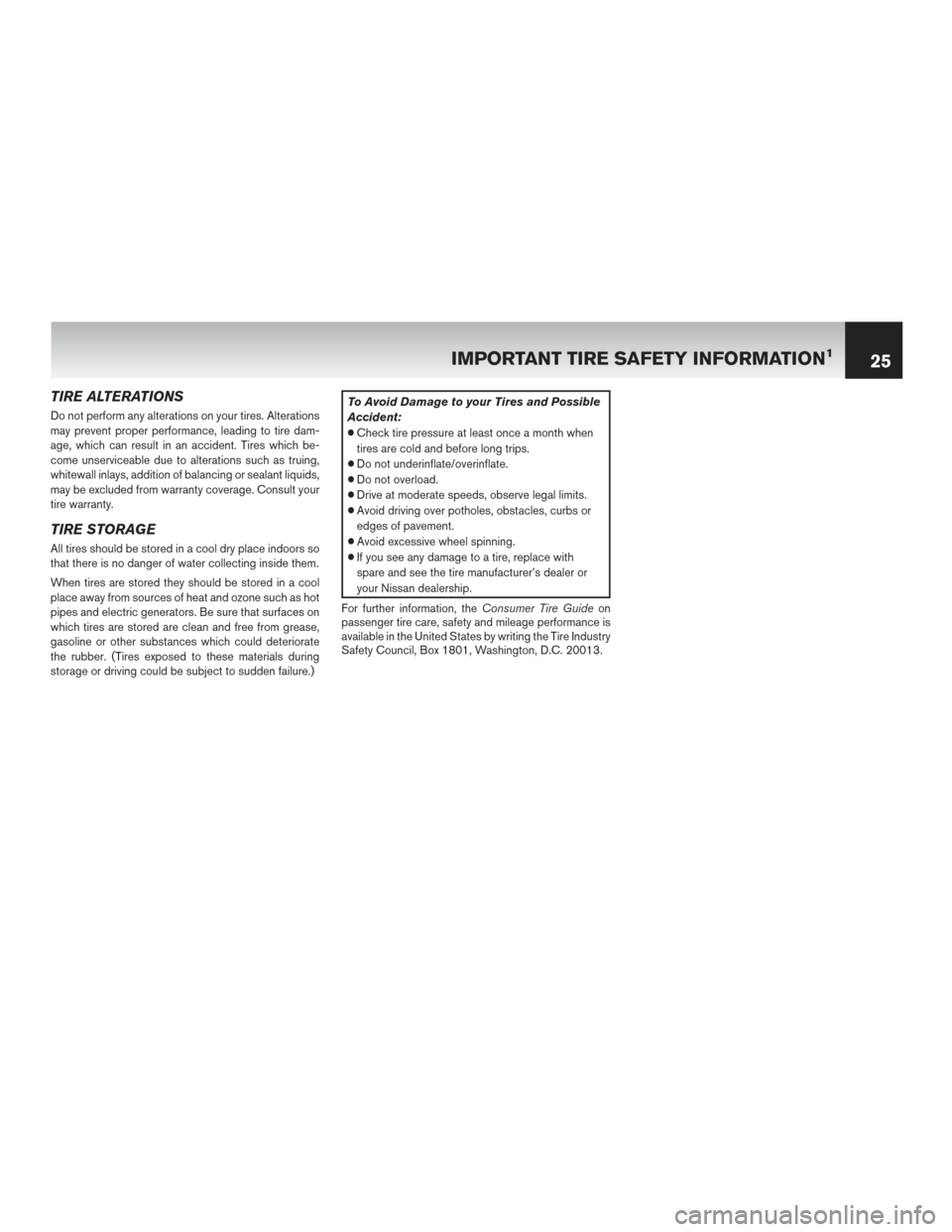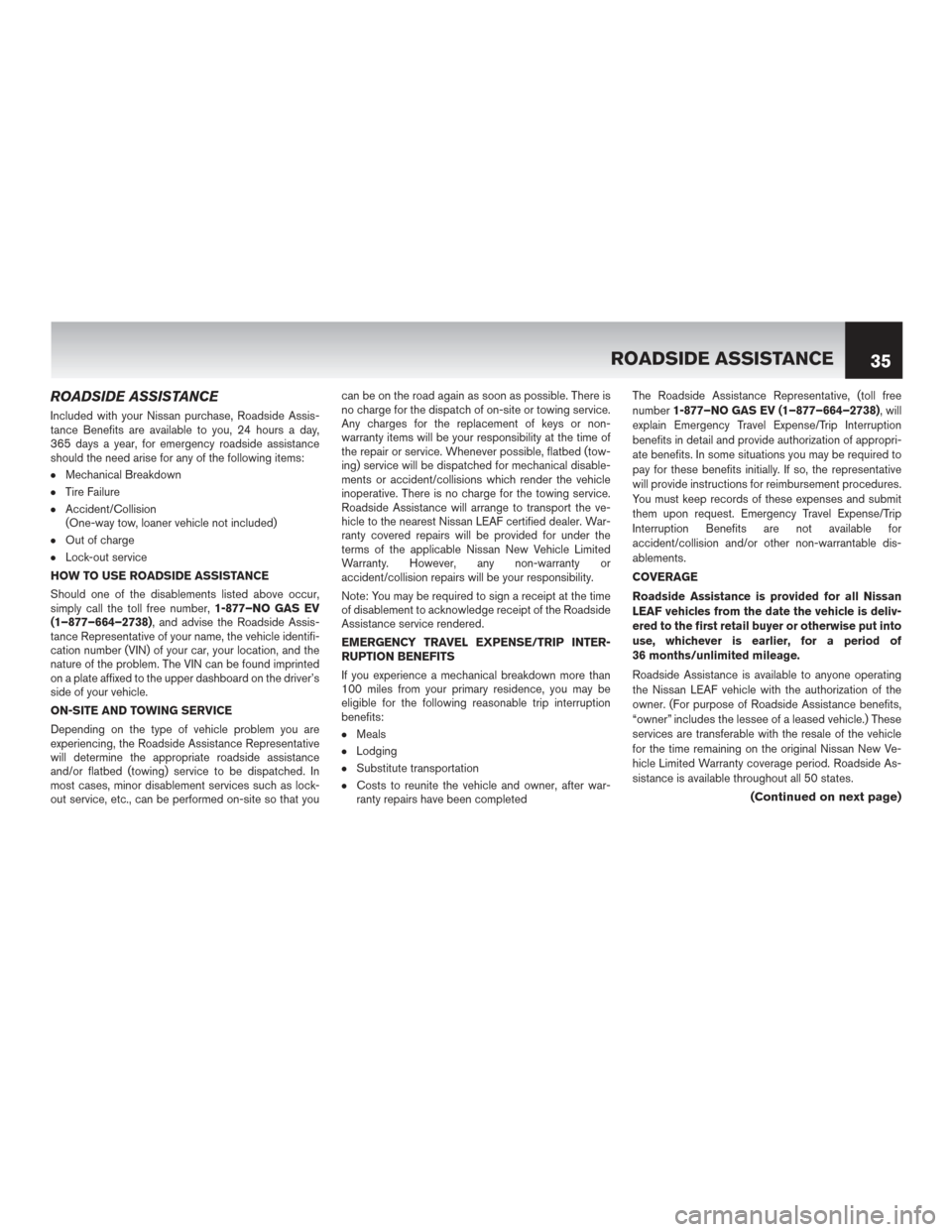2017 NISSAN LEAF flat tire
[x] Cancel search: flat tirePage 28 of 43

life of your tires, but adversely affect the handling char-
acteristics of your vehicle which could be dangerous. If
you detect irregular wear or vibration, have your align-
ment and balance checked immediately. Tires which
have been run underinflated will show more wear on the
shoulders than in the center of the tread.
HARD BRAKING
You must inspect your tires after any hard braking cir-
cumstances or after tires have slid on the pavement.
This can cause a flat spot in a section of the tire tread.
TIRE SPINNING
Never spin your tires above a speedometer reading of
35 mph (55 km/h) if your vehicle becomes stuck. The
centrifugal force generated by the free spinning
tire/wheel assembly may cause a sudden tire explosion,
resulting in vehicle damage and/or serious personal
injury or death. Never allow anyone to stand near or
behind a tire spinning at high speed while attempting to
push a vehicle that is stuck. When in mud, sand, snow,
ice or other slippery conditions, do not indulge in exces-
sive wheel spin. In such conditions, with automatic
transmission vehicles, by accelerating the engine ex-
cessively, it is possible to spin one of the drive tires
beyond its speed capability. This is also true when
balancing a drive tire/wheel assembly using the engine
of the vehicle to spin the wheel.
TIRE TREAD
Tires must be replaced when the depth of the tread
reaches 2/32 inch (1.6 mm) . Tires are manufactured
with tread wear indicators molded into the tire grooves
which indicate tread wearout. As tires approximate2/32 inch (1.6 mm) wearout, the tread gauge becomes
thinner and more vulnerable to the effects of road haz-
ards. Also, worn tires are more subject to hydroplaning,
which can cause loss of control. Therefore, visual tire
inspection becomes more crucial as the tires wear out.
WORN TIRES
Never drive on worn tires. Tires should be replaced by
trained personnel when 2/32nds of an inch tread depth
remains, as indicated by the tread wear indicators
molded into the tread grooves. In most states, it is illegal
to drive with less than 2/32nds of an inch of tread
remaining.
TIRE MIXING
For best performance
select tires similar in size and
load rating to the original equipment tires. It is recom-
mended that the same size and type of tire be used on
all four wheel positions. In certain tires, casing ply
material and ply construction may vary as indicated on
the sidewall of the tire. When changing or replacing
tires, it is preferred that all four tires are the same
construction type (i.e., High Performance, All Season,
Mud & Snow) and construction (Radial or Bias Ply) .
Before mixing tires of different types on a vehicle in any
configuration, be sure to check the vehicle OWNER’S
MANUAL for its recommendations.
Tires which meet the Rubber Manufacturer’s Associa-
tion (RMA) definition of mud and snow tires are marked
M/S, M+S, M&S. On such tires, this designation is
molded into the sidewall. Tires without this notation are
not recommended for mud and/or snow driving.
If snow tires are needed, it is necessary to select tires
equivalent in size and load rating to the original equipment tires. Always fit performance snow tires in sets of four (4)
for optimum mud & snow traction and maintenance of
vehicle handling characteristics. If you do not, it may
adversely affect the safety and handling of your vehicle. It
is also important to check the vehicle OWNER’S
MANUAL before mixing or matching tires on 4-wheel drive
vehicles as this may require special precautions.
Please refer to your OWNER’S MANUAL for more
information on tire replacement precautions.
TIRE ROTATION
Tires on your Nissan vehicle should be rotated every
7,500 miles or as irregular wear develops. If irregular
wear becomes apparent or if the wear rate on the tires is
perceptibly uneven, the tires should be rotated in such a
way to alleviate the problem. Check your vehicle for any
mechanical problems and correct if necessary. Any
rotation pattern or procedure may be followed including
those indicated in the OWNER’S MANUAL. Some tires
have arrows on the sidewall showing the direction in
which the tire should turn. When rotating this type of
tire, care must be taken to maintain the proper turning
direction as indicated by the arrows.
Some vehicles
have different tire sizes specified for front and rear
axles. Tires on these vehicles should not be rotated side
to side (unless they are non-directional). Where a tem-
porary type spare tire is available, it should not be
included in the tire rotation schedule. Such tires are
intended for temporary use only. Whenever only two
tires are replaced, the new tires should be put on the
rear axle of vehicles equipped with the same size tire on
all four wheel positions.
(Continued on next page)
24 IMPORTANT TIRE SAFETY INFORMATION1
Page 29 of 43

TIRE ALTERATIONS
Do not perform any alterations on your tires. Alterations
may prevent proper performance, leading to tire dam-
age, which can result in an accident. Tires which be-
come unserviceable due to alterations such as truing,
whitewall inlays, addition of balancing or sealant liquids,
may be excluded from warranty coverage. Consult your
tire warranty.
TIRE STORAGE
All tires should be stored in a cool dry place indoors so
that there is no danger of water collecting inside them.
When tires are stored they should be stored in a cool
place away from sources of heat and ozone such as hot
pipes and electric generators. Be sure that surfaces on
which tires are stored are clean and free from grease,
gasoline or other substances which could deteriorate
the rubber. (Tires exposed to these materials during
storage or driving could be subject to sudden failure.)
To Avoid Damage to your Tires and Possible
Accident:
●Check tire pressure at least once a month when
tires are cold and before long trips.
● Do not underinflate/overinflate.
● Do not overload.
● Drive at moderate speeds, observe legal limits.
● Avoid driving over potholes, obstacles, curbs or
edges of pavement.
● Avoid excessive wheel spinning.
● If you see any damage to a tire, replace with
spare and see the tire manufacturer’s dealer or
your Nissan dealership.
For further information, the Consumer Tire Guideon
passenger tire care, safety and mileage performance is
available in the United States by writing the Tire Industry
Safety Council, Box 1801, Washington, D.C. 20013.
IMPORTANT TIRE SAFETY INFORMATION125
Page 39 of 43

ROADSIDE ASSISTANCE
Included with your Nissan purchase, Roadside Assis-
tance Benefits are available to you, 24 hours a day,
365 days a year, for emergency roadside assistance
should the need arise for any of the following items:
●Mechanical Breakdown
●Tire Failure
●Accident/Collision
(One-way tow, loaner vehicle not included)
●Out of charge
●Lock-out service
HOW TO USE ROADSIDE ASSISTANCE
Should one of the disablements listed above occur,
simply call the toll free number, 1-877–NO GAS EV
(1–877–664–2738), and advise the Roadside Assis-
tance Representative of your name, the vehicle identifi-
cation number (VIN) of your car, your location, and the
nature of the problem. The VIN can be found imprinted
on a plate affixed to the upper dashboard on the driver’s
side of your vehicle.
ON-SITE AND TOWING SERVICE
Depending on the type of vehicle problem you are
experiencing, the Roadside Assistance Representative
will determine the appropriate roadside assistance
and/or flatbed (towing) service to be dispatched. In
most cases, minor disablement services such as lock-
out service, etc., can be performed on-site so that you can be on the road again as soon as possible. There is
no charge for the dispatch of on-site or towing service.
Any charges for the replacement of keys or non-
warranty items will be your responsibility at the time of
the repair or service. Whenever possible, flatbed (tow-
ing) service will be dispatched for mechanical disable-
ments or accident/collisions which render the vehicle
inoperative. There is no charge for the towing service.
Roadside Assistance will arrange to transport the ve-
hicle to the nearest Nissan LEAF certified dealer. War-
ranty covered repairs will be provided for under the
terms of the applicable Nissan New Vehicle Limited
Warranty. However, any non-warranty or
accident/collision repairs will be your responsibility.
Note: You may be required to sign a receipt at the time
of disablement to acknowledge receipt of the Roadside
Assistance service rendered.
EMERGENCY TRAVEL EXPENSE/TRIP INTER-
RUPTION BENEFITS
If you experience a mechanical breakdown more than
100 miles from your primary residence, you may be
eligible for the following reasonable trip interruption
benefits:
●Meals
●Lodging
●Substitute transportation
●Costs to reunite the vehicle and owner, after war-
ranty repairs have been completed The Roadside Assistance Representative, (toll free
number
1-877–NO GAS EV (1–877–664–2738), will
explain Emergency Travel Expense/Trip Interruption
benefits in detail and provide authorization of appropri-
ate benefits. In some situations you may be required to
pay for these benefits initially. If so, the representative
will provide instructions for reimbursement procedures.
You must keep records of these expenses and submit
them upon request. Emergency Travel Expense/Trip
Interruption Benefits are not available for
accident/collision and/or other non-warrantable dis-
ablements.
COVERAGE
Roadside Assistance is provided for all Nissan
LEAF vehicles from the date the vehicle is deliv-
ered to the first retail buyer or otherwise put into
use, whichever is earlier, for a period of
36 months/unlimited mileage.
Roadside Assistance is available to anyone operating
the Nissan LEAF vehicle with the authorization of the
owner. (For purpose of Roadside Assistance benefits,
“owner” includes the lessee of a leased vehicle.) These
services are transferable with the resale of the vehicle
for the time remaining on the original Nissan New Ve-
hicle Limited Warranty coverage period. Roadside As-
sistance is available throughout all 50 states.(Continued on next page)
ROADSIDE ASSISTANCE 35